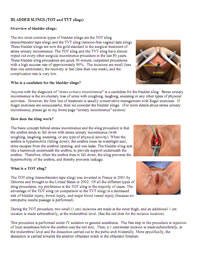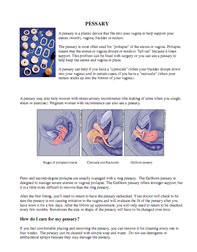Stress urinary incontinence
1. Stress Incontinence SURGICAL OPTIONS
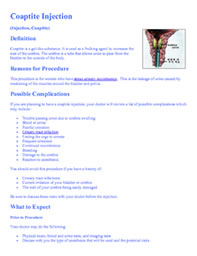 Coaptite Injection
Coaptite Injection
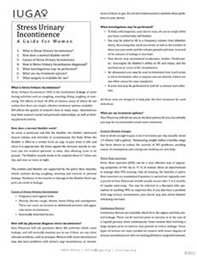 Stress Urinary Incontinence
Stress Urinary Incontinence
2. Stress Incontinence NONSURGICAL OPTIONS
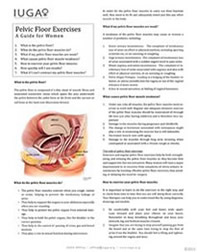 Pelvic floor exercises
Pelvic floor exercises
Additional Patient Resources
International Continence Society
http://www.icsoffice.org/
The International Continence Society (ICS) Web site offers you the latest research about incontinence. The ICS studies the voiding function of the lower urinary tract and encourages further research into the treatment of urinary dysfunction.
International Foundation for Functional Gastrointestinal Disorders
http://www.iffgd.org/
On the International Foundation for Functional Gastrointestinal Disorders (IFFGD) Web site, you can read up-to-date information about gastrointestinal (GI) disorders and learn about the IFFGD’s efforts to increase awareness about these stigmatic disorders, including fecal incontinence. The IFFGD is a nonprofit education and research organization. With eight Web sites, the IFFGD is a complete resource for gastrointestinal (GI) disorder information.
International Urogynecologic Association
http://www.iuga.org/
The International Urogynecological Association (IUGA) Web site provides plenty of information about PFD and links to several patient information Web sites. The IUGA is a worldwide organization committed to furthering knowledge regarding the care of women with pelvic floor dysfunction, including urinary incontinence.
National Association for Continence
http://www.nafc.org/
The NAFC Web site is a central meeting place for those suffering from incontinence and other pelvic floor disorders. Here, you can find a specialist in your area dedicated to bladder health. The NAFC is the world’s largest consumer advocacy organization for consumers, health care professionals and industry and is dedicated to public education and awareness of incontinence.
National Institutes of Health
http://www.nih.gov/
On the National Institutes of Health (NIH) Web site, you can learn about PFD symptoms, treatment options and resources for both patients and their families. The NIH is the primary federal agency for conducting and supporting medical research and is a trusted source of information about the nation’s health.
National Women’s Health Resource Center
http://www.healthywomen.org/
On the National Women’s Health Resource Center (NWHRC) Web site, you can find detailed information about PFD diagnosis, prevention and treatment options for patients. Additionally, the site offers print and online educational resources. The NWHRC is an independent health information source dedicated to the promotion of women’s health.
The Pelvic Floor Disorders Network
www.pfdnetwork.org
On the PFD Network Web site, you can access useful PFD information, highlights of recent research and information about the newest PFD clinical trials and treatments. The PFD Network is a group of doctors, nurses and researchers from across the country that is dedicated to improving the quality of life for women with pelvic organ prolapse and bladder and bowel control problems.
Simon Foundation for Continence (Approved language from the Foundation)
http://www.simonfoundation.org
The Simon Foundation for Continence is a national nonprofit organization dedicated to providing education and support to individuals with incontinence and their caregivers.
The Section on Women’s Health
http://www.womenshealthapta.org


